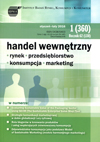A comparative analysis of the determinants of behaviours of Polish and German consumers aged 55+ in the innovative food market
A comparative analysis of the determinants of behaviours of Polish and German consumers aged 55+ in the innovative food market
Author(s): Romuald ZabrockiSubject(s): Business Economy / Management
Published by: Instytut Badań Rynku, Konsumpcji i Koniunktur
Keywords: consumer; food; innovations
Summary/Abstract: The aim of the paper was a comparative analysis of behaviours of Polish and German consumers aged 55+ on the market of innovative food. The survey was carried out among 428 responds from the Pomeranian voivodship and the land of Brema. It was shown that social and cultural differences, despite the positive attitude of both populations towards innovative food, diversify their market behaviours. German respondents declare greater knowledge with regard to innovative products, faster and more often decide to purchase such products then the surveyed Poles. Additionally, they are characterised by a lower level of neophobia. For the Germans surveyed innovative food is a permanent and important element of every day meals, whereas Polish people eat such food occasionally. While buying innovative food German consumers are governed mainly by its influence on health and how convenient it is to use, whereas the Polish respondents take into account its price. The level of adaptation of the innovative food market to the needs of the consumers aged 55+ is regarded by Polish seniors as satisfactory or low, whereas the Germans considered it to be good and very good. Disproportions found in the survey, which concern the position of Polish and German seniors on the market of innovative food should be a signal to verify the product and marketing strategy of Polish producers in order to adapt their offer more accurately to the economic possibilities and limitations of this group of buyers in the country. Further marginalisation of this market segment, at the threshold of silver economy development, seems a serious mistake.
Journal: Handel Wewnętrzny
- Issue Year: 366/2017
- Issue No: 1
- Page Range: 413-423
- Page Count: 11
- Language: English

